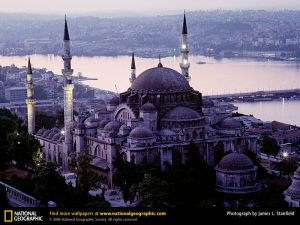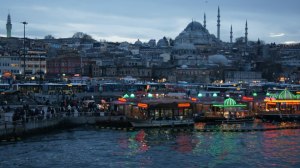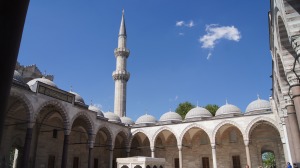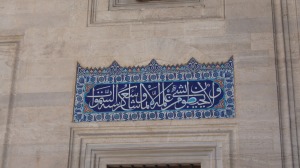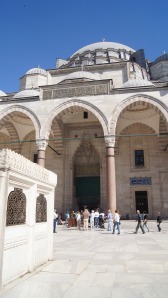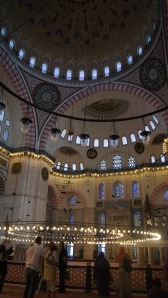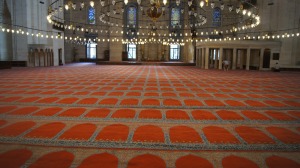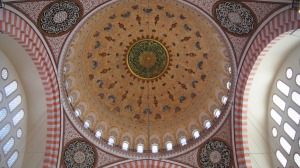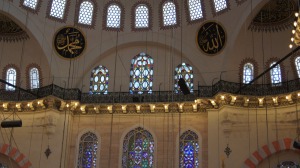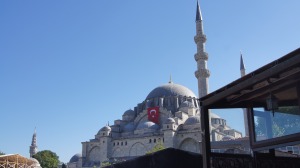 We went on holiday to the Mediterranean Sea, to the famous Ölüdeniz, or Dead Sea. We drove down, up and down mountain sides to get there. It was a beautiful drive. It’s located on the southwest border of Turkey, right on the Mediterranean Sea.
We went on holiday to the Mediterranean Sea, to the famous Ölüdeniz, or Dead Sea. We drove down, up and down mountain sides to get there. It was a beautiful drive. It’s located on the southwest border of Turkey, right on the Mediterranean Sea.
 This is the Blue Paradise. The white beach you see is part of a peninsula, which separates the lake from the rest of the Mediterranean Sea. That lake is the “dead sea,” where almost no wind comes down, so you’ll rarely see waves! (Picture credit: http://www.theclassytraveler.com/paragliding-and-the-blue-lagoon-in-oludeniz-turkey/)
This is the Blue Paradise. The white beach you see is part of a peninsula, which separates the lake from the rest of the Mediterranean Sea. That lake is the “dead sea,” where almost no wind comes down, so you’ll rarely see waves! (Picture credit: http://www.theclassytraveler.com/paragliding-and-the-blue-lagoon-in-oludeniz-turkey/)
 The walkway to the beach, it was longer than you’d expect, but totally worth it once you made it in. The cost was 6 lira (about $3) for me, and free for Süleyman with his Turkish (or international) student ID.
The walkway to the beach, it was longer than you’d expect, but totally worth it once you made it in. The cost was 6 lira (about $3) for me, and free for Süleyman with his Turkish (or international) student ID.
 My first view of the Mediterranean.
My first view of the Mediterranean.
 These beach loungers cost 14 Lira each (if I can remember correctly), and an umbrella cost more, but could be shared with two people. I didn’t mind laying on the ground, and as long as you have a towel, you can move the rocks to be comfortable… and a plus: no sandy towels!
These beach loungers cost 14 Lira each (if I can remember correctly), and an umbrella cost more, but could be shared with two people. I didn’t mind laying on the ground, and as long as you have a towel, you can move the rocks to be comfortable… and a plus: no sandy towels!
There were also food stands scattered around the peninsula with highly overpriced foods and snacks. We got a sandwich and watermelon for 15 Lira (about $7.50), and 1.5 liter water and a beer for about the same price. There were burgers, chicken sandwiches, soda, chips, etc.
 It was a rock beach, no sand. It looks beautiful from above, but is a horror to walk on. Bare feet hurt, flip-flops hurt; there is no winning, only pain, so be prepared for pain!
It was a rock beach, no sand. It looks beautiful from above, but is a horror to walk on. Bare feet hurt, flip-flops hurt; there is no winning, only pain, so be prepared for pain!
 It’s probably not the Dead Sea you’re thinking of; that’s in Jordan. It’s called the Dead Sea because, it’s location is so isolated that almost no wind comes down, which means almost no waves.
It’s probably not the Dead Sea you’re thinking of; that’s in Jordan. It’s called the Dead Sea because, it’s location is so isolated that almost no wind comes down, which means almost no waves.
 Another nickname is the “Blue Paradise.” And they weren’t kidding. It is so blue.
Another nickname is the “Blue Paradise.” And they weren’t kidding. It is so blue.
 Just look at that water. It’s so beautiful. But be warned: this is the saltiest water I’ve ever accidentally swallowed. It’s really terrible. If you slip and swallow, you will be coughing and reaching for your water bottle (definitely bring one, or buy one there!), it’s very dehydrating just being in the water.
Just look at that water. It’s so beautiful. But be warned: this is the saltiest water I’ve ever accidentally swallowed. It’s really terrible. If you slip and swallow, you will be coughing and reaching for your water bottle (definitely bring one, or buy one there!), it’s very dehydrating just being in the water.
 We went to the more isolated part of the peninsula originally, the northern side. When we had been there about two hours we wanted to leave, but on our walk around the peninsula, we decided to go for one more dip. That dip turned into another 3 or 4 hours in the water. And we did not regret that. With water that warm and that beautiful, (besides the rock beach) how could we say no?
We went to the more isolated part of the peninsula originally, the northern side. When we had been there about two hours we wanted to leave, but on our walk around the peninsula, we decided to go for one more dip. That dip turned into another 3 or 4 hours in the water. And we did not regret that. With water that warm and that beautiful, (besides the rock beach) how could we say no?
 On the southern side of the peninsula. This side was much more of our personalities and we were much more relaxed there, there were more people our age swimming out further than the rope boundaries like we were. We swam to the smaller rock formation, on the left, and Süleyman, being the daredevil he is, jumped off into the water. It was a good 9 meters (30 feet) at least!
On the southern side of the peninsula. This side was much more of our personalities and we were much more relaxed there, there were more people our age swimming out further than the rope boundaries like we were. We swam to the smaller rock formation, on the left, and Süleyman, being the daredevil he is, jumped off into the water. It was a good 9 meters (30 feet) at least!
 Here’s a close up of the rock. There are people near the bottom. Click on the picture to get its full size to see the comparison.
Here’s a close up of the rock. There are people near the bottom. Click on the picture to get its full size to see the comparison.
 Big clouds hung over and rained on the mountains, but never made it to the Blue Paradise, it just made a beautiful lighting setting.
Big clouds hung over and rained on the mountains, but never made it to the Blue Paradise, it just made a beautiful lighting setting.
 There were a lot of tourist-related things to do in Fethiye, like paragliding (you’ll see that everywhere!), and boat tours! And because it’s such a tourist-crazy place, many things are in English, like the boat tour we went on. We met people from Russia, Turkey, and even Sweden on our tour.
There were a lot of tourist-related things to do in Fethiye, like paragliding (you’ll see that everywhere!), and boat tours! And because it’s such a tourist-crazy place, many things are in English, like the boat tour we went on. We met people from Russia, Turkey, and even Sweden on our tour.
 There were many tour boats that were on the same schedule. The tour lasted from 9 am to about 4 pm. We got one boat, and each paid about 20 Lira (about $10) for the entire day. It included five or six stops nearby and lunch. Granted, lunch wasn’t very good, but for 14 Lira all day, I’d say it was a good deal! Süleyman made friends with the captain and found out he owned the boat, so it was cheaper than some of the other tours, and they all made the same tours. All we were paying for was the gas. They made most of their money on drinks, sweets, ice cream and snacks between stops.
There were many tour boats that were on the same schedule. The tour lasted from 9 am to about 4 pm. We got one boat, and each paid about 20 Lira (about $10) for the entire day. It included five or six stops nearby and lunch. Granted, lunch wasn’t very good, but for 14 Lira all day, I’d say it was a good deal! Süleyman made friends with the captain and found out he owned the boat, so it was cheaper than some of the other tours, and they all made the same tours. All we were paying for was the gas. They made most of their money on drinks, sweets, ice cream and snacks between stops.
 I just adore being on boats, so I was pretty content bobbing up and down.
I just adore being on boats, so I was pretty content bobbing up and down.
 The view out the side. That gorgeous blue will never be replicated in my mind. It was perfect.
The view out the side. That gorgeous blue will never be replicated in my mind. It was perfect.
 Unfortunately because the water was so choppy that day, we couldn’t go to the first stop, which was The Blue Cave (Mavi Mağara), but we got to float by it.
Unfortunately because the water was so choppy that day, we couldn’t go to the first stop, which was The Blue Cave (Mavi Mağara), but we got to float by it.
 The next stop was Butterfly Valley (Kelebekler Vadisi). Entry fee is 5 Lira, or about $2.50.
The next stop was Butterfly Valley (Kelebekler Vadisi). Entry fee is 5 Lira, or about $2.50.
 It was beautiful, but stressful for me. I wasn’t having the best morning, and hiking up a mountain side in bad quality flip-flops didn’t help.
It was beautiful, but stressful for me. I wasn’t having the best morning, and hiking up a mountain side in bad quality flip-flops didn’t help.
 But the end result was worth it.
But the end result was worth it.
 The goal for most people is to see and drink from the freshwater waterfall. But we found out later that you can climb higher and it’s even better. Süleyman is right next to the waterfall in this picture.
The goal for most people is to see and drink from the freshwater waterfall. But we found out later that you can climb higher and it’s even better. Süleyman is right next to the waterfall in this picture.
 A beautiful shot I got of some of the early flowers blooming. Surprisingly, we only saw two butterflies when we were there. But later on in the summer is when it’s supposed to live up to its name.
A beautiful shot I got of some of the early flowers blooming. Surprisingly, we only saw two butterflies when we were there. But later on in the summer is when it’s supposed to live up to its name.
 Resting on our way back down to catch the boat. We got about 45 minutes there.
Resting on our way back down to catch the boat. We got about 45 minutes there.
 Our next stop was for lunch. After the thrilling meal of reheated chicken and salad, the captain started the water slide. That’s right everyone, you read that correctly. A water slide. On. The. Boat. It was pretty much a straight shot down at first, then after some crazy twists, you were ejected out the opposite side. I went down twice, I screamed like a little girl both times.
Our next stop was for lunch. After the thrilling meal of reheated chicken and salad, the captain started the water slide. That’s right everyone, you read that correctly. A water slide. On. The. Boat. It was pretty much a straight shot down at first, then after some crazy twists, you were ejected out the opposite side. I went down twice, I screamed like a little girl both times.
 The top floor of the boat had comfy foam mats and a little seating, as well as the water slide opening. The bottom floor had picnic-style table and seating.
The top floor of the boat had comfy foam mats and a little seating, as well as the water slide opening. The bottom floor had picnic-style table and seating.
 Speaking of screaming like a little girl, I did that again when I jumped off the two-story boat. I know, I can’t believe I did it either, and only the pictures would help my friends believe it.
Speaking of screaming like a little girl, I did that again when I jumped off the two-story boat. I know, I can’t believe I did it either, and only the pictures would help my friends believe it.
 We got matching towels on our way down to Fethiye too, his was brown and green, mine was purple and blue. Aren’t we adorable?
We got matching towels on our way down to Fethiye too, his was brown and green, mine was purple and blue. Aren’t we adorable?
The same place we stopped for lunch and jumping off of boats and such was the really cool place where the cold freshwater spring from the mountain met the warm salty water from the sea. Weird as it sounds, the top of the water in that area was very cold (fresh is less dense than salty water) and the lower you went the warmer it got. It was so weird, I loved experiencing that! Süleyman dove down a little deeper to feel more difference, and he said going back up hurt his head because of how cold it was! Awesome!
 This is St. Nicholas Island (Adası), where according to the plaque near the entrance (8 Lira to enter), “St. Nicholas may have lived or visited this island.” We didn’t feel like forking over a whopping $4 to go in, so we decided to swim and collect rocks instead. But the deteriorating stone buildings were wonderful!
This is St. Nicholas Island (Adası), where according to the plaque near the entrance (8 Lira to enter), “St. Nicholas may have lived or visited this island.” We didn’t feel like forking over a whopping $4 to go in, so we decided to swim and collect rocks instead. But the deteriorating stone buildings were wonderful!
 A better view of the architecture of St. Nicholas Island. It contains 4 large churches, many vaulted tombs and is residential too. We saw the backside of this island at another beach we went to.
A better view of the architecture of St. Nicholas Island. It contains 4 large churches, many vaulted tombs and is residential too. We saw the backside of this island at another beach we went to.
 When we would stop for a while, smaller boats would sit nearby and sell gözleme (sort of like a Turkish quesadilla), that they cook right on their boat.
When we would stop for a while, smaller boats would sit nearby and sell gözleme (sort of like a Turkish quesadilla), that they cook right on their boat.
 Camel Beach. Süleyman took this picture from the boat (that’s me in the water). Supposedly the big tan rock on the side of the mountain looks like a camel’s hump, hence the name.
Camel Beach. Süleyman took this picture from the boat (that’s me in the water). Supposedly the big tan rock on the side of the mountain looks like a camel’s hump, hence the name.
 The view from Camel Beach. Those big rocks were so different from many other rocks in the area, these were black. the sand at this beach was also much darker than the other beaches in the area.
The view from Camel Beach. Those big rocks were so different from many other rocks in the area, these were black. the sand at this beach was also much darker than the other beaches in the area.
 The next day, we ventured outside of Fethiye to Kayaköy, about 4 miles (6 km) south of Fethiye. Anatolian Greek speaking Christians lived here until 1923 when Greece and Turkey signed an agreement about a population exchange. It was built on the ancient city of Carmylessus in the 18th century.
The next day, we ventured outside of Fethiye to Kayaköy, about 4 miles (6 km) south of Fethiye. Anatolian Greek speaking Christians lived here until 1923 when Greece and Turkey signed an agreement about a population exchange. It was built on the ancient city of Carmylessus in the 18th century.
 Apparently in the 1900 census, there were about 2,000 residents here, and over 500 residences. It was very eerie being there. While it was abandoned for a reason of just boundaries, it still seemed like there was so much history there and it felt like we weren’t quite alone. I can’t even imagine being there at night.
Apparently in the 1900 census, there were about 2,000 residents here, and over 500 residences. It was very eerie being there. While it was abandoned for a reason of just boundaries, it still seemed like there was so much history there and it felt like we weren’t quite alone. I can’t even imagine being there at night.
 One of the buildings. We saw a few sheep in one building, and a horse resting in the shade of another, so it seems that farmers in the area are still using the area. There is a 5 Lira fee (if I remember correctly), but we got in for free accidentally. We took an entrance that wasn’t guarded apparently, so..oops!
One of the buildings. We saw a few sheep in one building, and a horse resting in the shade of another, so it seems that farmers in the area are still using the area. There is a 5 Lira fee (if I remember correctly), but we got in for free accidentally. We took an entrance that wasn’t guarded apparently, so..oops!
 The path we took around the buildings. It was very difficult and careful stepping was a necessity! Be careful!
The path we took around the buildings. It was very difficult and careful stepping was a necessity! Be careful!
 The “steps” up the hillside. Surprisingly difficult to climb, and even harder to walk down them.
The “steps” up the hillside. Surprisingly difficult to climb, and even harder to walk down them.
 The lower of the two churches. There is an upper church and a lower church.
The lower of the two churches. There is an upper church and a lower church.
 Before exploring the abandoned village, we enjoyed a lunch of gözleme. It’s almost like a Turkish quesadilla. It’s made with thin bread, cheese and it’s fried on both sides in a special oven. The cheese is almost like feta, but less strong. You can get different types of cheese, or other additions. I got spinach in mine, but you can get meat or other vegetables too.
Before exploring the abandoned village, we enjoyed a lunch of gözleme. It’s almost like a Turkish quesadilla. It’s made with thin bread, cheese and it’s fried on both sides in a special oven. The cheese is almost like feta, but less strong. You can get different types of cheese, or other additions. I got spinach in mine, but you can get meat or other vegetables too.
 The oven used to make gözleme.
The oven used to make gözleme.
 An adorable camel mother and her calf at the foot of the abandoned village, ready for walking tours.
An adorable camel mother and her calf at the foot of the abandoned village, ready for walking tours.
 An entrance to a restaurant near Kayaköy.
An entrance to a restaurant near Kayaköy.
 It was relieving having so much English around me. Most of the people there spoke fluent English, or at least had a few phrases down. We found “Happy Pork Shop” in Fethiye… one of many pork shops actually! This was the only place in Turkey I saw any reference to pork at all; it was very surprising! Turkey is 99% Muslim, and part of the religion is to not eat pork, so normally it would be easy to find food without it, but not in Fethiye. There are so many tourists from other countries, I guess it just makes sense to give them what they’re used to!
It was relieving having so much English around me. Most of the people there spoke fluent English, or at least had a few phrases down. We found “Happy Pork Shop” in Fethiye… one of many pork shops actually! This was the only place in Turkey I saw any reference to pork at all; it was very surprising! Turkey is 99% Muslim, and part of the religion is to not eat pork, so normally it would be easy to find food without it, but not in Fethiye. There are so many tourists from other countries, I guess it just makes sense to give them what they’re used to!
 Such a great sign I found outside a restaurant in the downtown area in Fethiye. If you can’t read it: “Wanted, Customer. No previous experience needed as full training will be given. Please apply within.”
Such a great sign I found outside a restaurant in the downtown area in Fethiye. If you can’t read it: “Wanted, Customer. No previous experience needed as full training will be given. Please apply within.”
So a few reminders about Ölüdeniz: It is so breathtakingly beautiful, the “best” beach has only rocks, and finally the water is extremely salty. And definitely take a boat tour. It’s so relaxing, and you get to see some of the spots only available by boat! Even though there were a lot of bad things about this place, overall, it was amazing, and I’d love to go back.
Some of the information I used here were from these websites:
http://en.wikipedia.org/wiki/Gemiler_Island
http://en.wikipedia.org/wiki/Kayak%C3%B6y
 Here is a large group of people, hearing about the people killed in the protests. Some people were wearing pictures of the victims over their faces.
Here is a large group of people, hearing about the people killed in the protests. Some people were wearing pictures of the victims over their faces. There were lines of police buses and many police officers behind a line, waiting for any suspicious activity.
There were lines of police buses and many police officers behind a line, waiting for any suspicious activity. This building is the Ataturk Cultural Center, or AKM, was an important symbol during the protests. Apparently the government was planning on demolishing the building and building a new one in its place. AKM is a symbol of the Ataturk, and many citizens are highly patriotic, hated the idea of destroying a symbol of the man who changed their country. Protesters climbed to the roof, hung flags and painted the windows.
This building is the Ataturk Cultural Center, or AKM, was an important symbol during the protests. Apparently the government was planning on demolishing the building and building a new one in its place. AKM is a symbol of the Ataturk, and many citizens are highly patriotic, hated the idea of destroying a symbol of the man who changed their country. Protesters climbed to the roof, hung flags and painted the windows. “Standing Man” was such a strong symbol during the protests. He silently and calmly stood, staring at the AKM for hours, before being forced to leave. He almost instantly became a viral hit, and many people joined him.
“Standing Man” was such a strong symbol during the protests. He silently and calmly stood, staring at the AKM for hours, before being forced to leave. He almost instantly became a viral hit, and many people joined him. Here are a few participants representing Standing Man. The woman on the left is facing Gezi Park, while the majority of the people are facing AKM.
Here are a few participants representing Standing Man. The woman on the left is facing Gezi Park, while the majority of the people are facing AKM. These two men show their pride for their country by waving the Turkish flag, and a modified flag with the Ataturk’s picture overlaying it.
These two men show their pride for their country by waving the Turkish flag, and a modified flag with the Ataturk’s picture overlaying it. (photo credit) We ran into our own tension with the police. We went down to the Bosporus River to pick up a few friends who had arrived by boat, and we saw massive amounts of police officers running into Taxim Square and many slowly walking out, exhausted. We asked one of the police officers leaving Taxim Square about open roads and he could barely answer he was so exhausted. This was a terrible example of how the police weren’t very happy about the situation either, they were simply following orders.
(photo credit) We ran into our own tension with the police. We went down to the Bosporus River to pick up a few friends who had arrived by boat, and we saw massive amounts of police officers running into Taxim Square and many slowly walking out, exhausted. We asked one of the police officers leaving Taxim Square about open roads and he could barely answer he was so exhausted. This was a terrible example of how the police weren’t very happy about the situation either, they were simply following orders. (photo credit) It wasn’t just protesters being attacked. Innocent people, and animals, not involved were injured as well. I even heard of a veterinarian who held a free clinic for injured animals of the attacks.
(photo credit) It wasn’t just protesters being attacked. Innocent people, and animals, not involved were injured as well. I even heard of a veterinarian who held a free clinic for injured animals of the attacks. (photo credit) This woman in red also became an iconic symbol of never letting down.
(photo credit) This woman in red also became an iconic symbol of never letting down. Here is Taxim’s pedestrian shopping area, absolutely full of people, which was such a wonderful view for me, after seeing all of the violence on the television.
Here is Taxim’s pedestrian shopping area, absolutely full of people, which was such a wonderful view for me, after seeing all of the violence on the television. Many of the businesses offered help and free water to protesters, especially after getting the chemicals in their eyes. But there were a few that refused to help. Most of those businesses were attacked by the protesters, as well as a few American businesses (for some reason), such as Starbucks and this Levi’s, which had cracks in the windows, like someone had thrown a large rock at it.
Many of the businesses offered help and free water to protesters, especially after getting the chemicals in their eyes. But there were a few that refused to help. Most of those businesses were attacked by the protesters, as well as a few American businesses (for some reason), such as Starbucks and this Levi’s, which had cracks in the windows, like someone had thrown a large rock at it. This was another wonderful site for me to see. I have talked about the trolley before, how it does up and down Taxim and on the weekends, there is an extra car with a band on it. This particular weekend, we saw a wonderful LGBT pride band. They handed out posters with the LGBT rainbow flag on them and invited everyone to join them in a protest later on in the weekend. Turkey is about 99% Muslim, and in Islam it is a sin to be homosexual. While Turkey is not the most conservative country, especially not in Istanbul, it still has a lot of resistance to this group of people. They were very brave to go out in public singing about LGBT and being proud.
This was another wonderful site for me to see. I have talked about the trolley before, how it does up and down Taxim and on the weekends, there is an extra car with a band on it. This particular weekend, we saw a wonderful LGBT pride band. They handed out posters with the LGBT rainbow flag on them and invited everyone to join them in a protest later on in the weekend. Turkey is about 99% Muslim, and in Islam it is a sin to be homosexual. While Turkey is not the most conservative country, especially not in Istanbul, it still has a lot of resistance to this group of people. They were very brave to go out in public singing about LGBT and being proud.



















































































